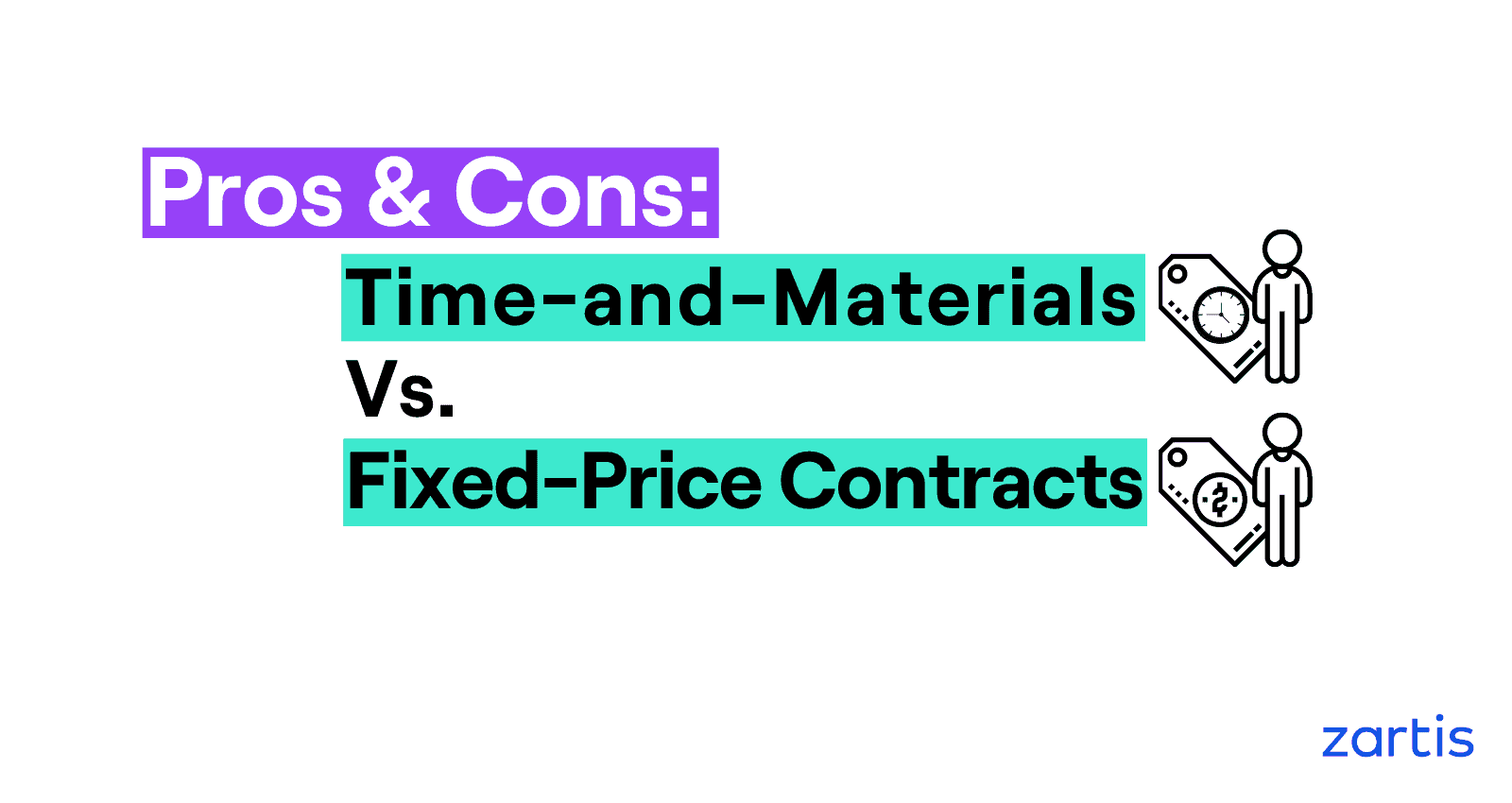So, you’ve decided to outsource your software project development. Presumably, you’ve also picked the best outsourcing model for your needs. You may have even selected an outsourcing service provider. So far, so good.
However, there is one more critical decision you need to make before getting your project off the ground. Chances are you’d have to choose between the two most common pricing models in software outsourcing: time-and-materials vs. fixed-price contracts.
Which one would make a better match for you depends on a number of factors. These range from your budget and product specifications to the complexity and size of the project.
Time and Materials vs. Fixed Price Billing: What’s the Difference?
A quick note on the industry lingo: time-and-materials often goes by “time & materials” and the (rather inelegant) shorthand “T and M” or “T&M.”
So, what is the difference between T&M and fixed-price contracts?
What Is a Fixed-Price Contract?
A fixed-price contract is an example of project-based outsourcing that was widely used in traditional offshoring.
This pricing framework is a type of billing where the customer and service provider agree on a firm price for the entire project in advance. Any extra work and additional costs that are not covered by the original agreement are paid separately.
What Is a Time-and-Materials Contract?
Before we answer this, we need to tackle another question, namely, “What does time and materials mean?”
It’s pretty self-explanatory: the phrase refers to the time (as in actual hours and days) and materials an outsourcing vendor spends on a given project. This includes the work done by the developers, QAs, as well as, if applicable – the product owner, architect, and everyone else on the dedicated development team.
In that sense, a time-and-materials pricing model is a type of contract where a software development company bills you for the hours or days worked plus the cost of any other materials (e.g. hardware, software licenses) used in the process. What this means is that the vendor will tell you how much the resources you’ll need are going to cost, i.e., developer X will cost Y EUR or USD per day. While you can ask a provider for their technical input and advice, it will be ultimately up to you, as the client, to determine how many software engineers you are going to need — and for how long. Having a detailed roadmap will help with estimating the overall cost, but you also have the flexibility to scale up or down the team, as your needs evolve and change.
Nowadays, time-and-materials is quickly becoming the most popular type of project pricing in extended development.
Pros and Cons of T&M and Fixed-Price Contracts
Advantages of Fixed-Price Outsourcing
Traditionally, the vast majority of outsourcing contracts would use some form of fixed-fee pricing — and no wonder. There are many benefits to a firm fixed-price contract.
1. Predictability
The predictability that comes with a fixed-price agreement is appealing to many business owners. Knowing exactly how much their product development will cost allows them to plan their expenses with greater certainty and better allocate the organization’s resources. It also minimizes potential risks and might help some businesses save money in the long term — but not always, as we shall see in a bit.
2. Transparency
Fixed-fee contracts tend to be very thorough. They set out detailed requirements and product specs and often include pretty rigid timeframes for the various stages of the development process. Not only does that ensure a high degree of compliance, but it also helps the outsourcing company and the client agree on a clear (and shared) vision of the final product from the outset.
3. Easy Management
As long as no major surprises come up, the average fixed-fee agreement will require little interaction between the outsourcing vendor and the client. The detailed breakdown of every task and milestone means that the dedicated team will be able to work fairly independently and with limited supervision.
Disadvantages of the Fixed-Price Model
1. Rigidity
One of the main drawbacks of this type of pricing is its lack of flexibility. As time goes by, your requirements and deliverables can change — especially with larger and more complex projects. If you’ve started with a fixed-price model, this would mean renegotiating the deal from scratch.
2. May Not Be Cost-Effective
Agreeing on a fixed price is great if you are buying a ready-made digital product off the shelf. You know just how much you will be paying and what you get in return.
However, if you are looking to build tailor-made software, your product idea will likely evolve as the development process moves forward. And under a fixed-price contract, you will not be able to make any adjustments without incurring extra costs. In the long term, you may end up paying way more than you bargained for.
3. Limited Accountability
The day-to-day management of a typical fixed-price project is usually done by the outsourcing vendor. If you were hoping to have a tighter grip on the software development process and the quality of the code, this might be the wrong pricing model for you.
Benefits of the Time-and-Materials Pricing Model
Time-and-materials contracts are now more popular than fixed-fee arrangements. Here are some reasons why that might be the case.
4. Flexibility
A T&M outsourcing contract is flexible enough to allow you to shift directions and change the product specs and project requirements. You don’t have to stick to the original software project plan — you can modify the work scope as needed.
After the beta testing phase, for instance, you may decide to introduce additional features, radically new designs, or other improvements that were not set out in the initial agreement. This way, you get to involve your future users in the development of the product, ensuring a better customer experience.
You are free to adjust not only the product itself but the method of work, too — from varying the workloads to changing the project timelines.
Greater Cost Savings for Complex Projects
If you are running dynamic long-term projects, a time-and-materials contract can give you the ability to tweak your strategy — and even your entire project framework — at much more competitive prices than a traditional fixed-price agreement.
Agile Project Management
The flexible and open nature of T&M contracts encourages vendor-client collaboration and cross-functional team efforts. It also allows for the integration of user feedback and preferences in real time. This type of adaptive, evolutionary development and continuous quality improvement is what agile development and strategic outsourcing are all about.
Time-and-Materials or Fixed-Price — Which Model Is Right for You?
No two software development projects are alike. However, when it comes to the thorny time and materials vs. fixed price dilemma, there are some rules of thumb.
You might benefit from a fixed-price approach if you:
- Have a tight budget and a very clear idea as to what you need
- Are working on short-term and low-complexity projects
- Have rigid timelines with little wiggle room
- Value predictability over flexibility
- Have a more laid-back approach to project management
- Need to keep financial risks to a minimum*
*Though, keep in mind that the fixed price model can also come with hidden costs, as outlined above.
Alternatively, a time-and-materials contract would probably be a better fit if you:
- Are pursuing long-term, complex, and/or large-scale projects
- Want the freedom to change the project scope and product specifications on the basis of changing needs without the limitations of a fixed-price agreement
- Want to implement agile methodology
- Value direct communication with your developers and a collaborative approach to software development
Fixed-Price |
Time-and-Materials |
| Predictable | Flexible and easily adjustable |
| Short-term, simple, small-scale projects | Long-term, complex, large-scale projects |
| Fixed or limited budget | Malleable budget |
| Tight or fixed deadlines | Flexible timeframe |
| Limited client involvement in daily management | More client involvement in team management |
| Waterfall development | Agile development |
Time and Materials vs. Fixed Price Contracts: The Bottom Line
Many of our clients who want to learn how to manage a software development project often ask us what our preferred contract type is.
So, what’s our verdict on the time and materials vs. fixed price issue?
While both pricing models have their pros and cons, at Zartis, we favor time-and-materials agreements. They empower us to build long-term relationships with our clients, focus on delivering high-quality services, and cater to your changing needs.
Do you have an outsourcing project in mind yourself? Drop us a line. We’d love to help.





